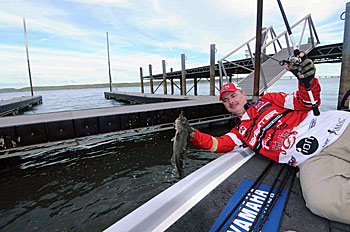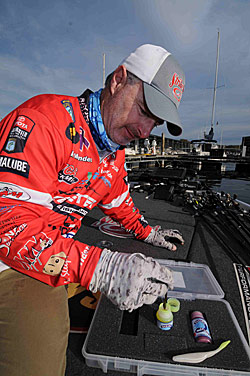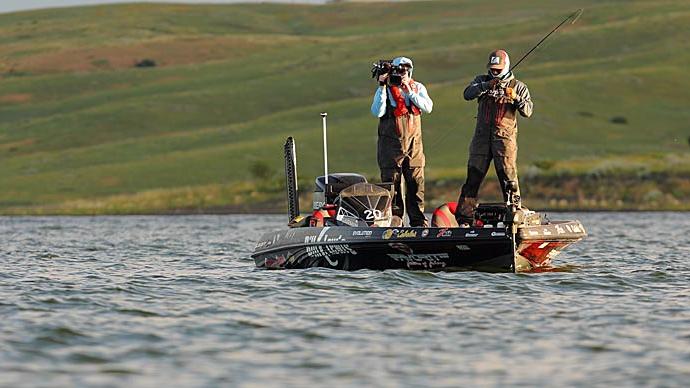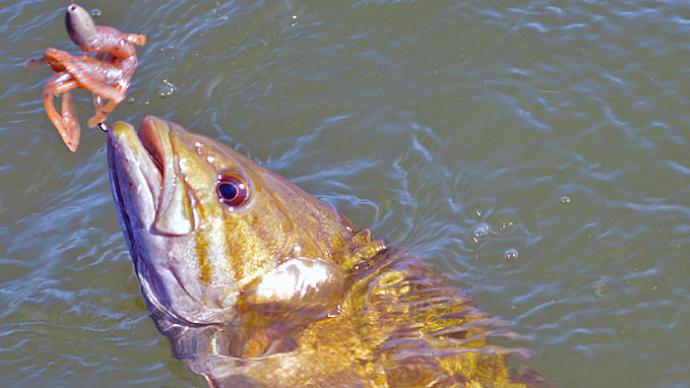
Lure manufacturers make soft plastics in a wide array of fish-catching colors, but sometimes an added tint can make a big difference.
Those are times when Bassmaster Elite Series pro Mark Menendez enhances his soft plastic bait by dipping it in a lure dye. “It all has to do with visibility,” Menendez says. “Whether you are fishing in depth, low light, or mud, you must make the bait more visible for the bass to see sometimes.”
The Kentucky pro notices that dipping soft plastics has worked best for him in tournaments during the spawn and summer. He likes dipping his soft plastics in dye during the spawn because it helps him see the lure better on the nest when sight fishing. The high heat and hot water make bass lethargic in the summertime, so Menendez adds some color to his baits to coax bass into biting. “That little extra flash sometimes is enough to get the fish fired up and take the bait instead of pecking around on it,” Menendez says.
When Menendez wants to do some lure dipping, he relies on the D2Fishing Products Dyesafe Containment System, which includes a plastic box with foam inside for holding two 2-ounce bottles of Dyeing2Fish dye. With the containment system, Menendez can set the bottle in the foam slot, dip the bait in the dye, and lay the bait on the foam to dry for 5 to 10 seconds. This prevents the dye from dripping on his boat carpet or smearing his hands.
Dyeing2Fish dyes in bright colors are Menendez’s favorites for dipping. “The colors are fluorescent, and fluorescents don’t change when the lures get down in low light or depth,” he says. “The physics of light changes our color spectrum if the colors are non-fluorescent. So fluorescents hold their identity, and that is a big key.”
The three-time B.A.S.S. winner rates fluorescent chartreuse and fluorescent orange as the two most popular dyes for bass fishing. “Reds and blues certainly have their fans as well,” he says.

Dipping baits for clear-water presentations is also effective for Menendez. “That is when I find orange shines, particularly when using creature-style baits mimicking a crayfish,” he says. “There are a lot of crayfish that are a kind of a green pumpkin or olive green that are accentuated with orange dots, and you can match the hatch like that (with orange dye).” When sight fishing in the spring, Menendez will dye a green pumpkin or white soft plastic completely chartreuse or orange to see the lure better in clear water. Menendez notices bass in tidal waters eat a lot of blue crabs, so he dips his green pumpkin lures in blue dye to mimic the crabs.
Soft plastic lures in transparent colors such as green pumpkin, watermelon, and clear blue are best for dipping in dye. “You want contrast, so the green pumpkins do well with just about every color (of dye) because you can have a real contrast in colors,” says Menendez. “Tough colors to dye are the darkest, like black neon and black/blue flake.”
The five-time Bassmaster Classic qualifier either dips his lures into the dye bottle or uses Q-tips to paint dots with the dye. He applies the dye to various parts of the lure’s body. “The tail is probably the simplest, quickest, and most used (for dipping,” he says. “I have found that putting color on the head of the lure sometimes is the deal when the fish are lethargic.”
Sometimes Menendez gets a mottling effect on his soft plastics by placing the baits in a plastic bag with some dye and then swishing the lures in the bag. “You can get some cool color combinations that way,” he says.
He also mixes chartreuse lures with blue dye to make a vivid green. “It’s a fantastic color when dealing with spotted bass, and it’s a great color to put on a tiny grub and fish for crappie,” Menendez says. He calls his color concoction “Kentucky Lake lime.”
The dye on his baits can also be altered by the length of time he dips his lure in the dye bottle. “I can dip the lure and hold it and get more integrity and more strength in color the longer I hold it in the bottle,” he says. “A one-second dip will give me a nice color, and a five-second dip will give me a much stronger vivid color.”
During the spawning season, Menendez puts a green pumpkin bait and red dye in a plastic bag and swishes it around to get a swirling effect on the lures. He will also paint dots with red dye on the back of a plastic lizard and dye the legs of the lizard red. Menendez believes the added touch of red makes a bass more belligerent.
“I may not get more bites but what I get are stronger harder bites,” he says. “So pay attention to how strong a bite you are getting, and if the fish are aggressive, you’ve probably got the right amount of color on your bait. If the bites or slow or soft, you might want to add a little more color, so you might be able to fire them up.”
The Dyeing2Fish dyes also come with scents such as garlic, crayfish, shade, and grape jelly (anise). Menendez recommends using the grape jelly scent to mask human sunscreen and gasoline odors. He uses the shad scent most of the time and tries the crayfish scent when he notices bass are foraging on the crustaceans.
BassResource may receive a portion of revenues if you make a purchase using a link above.




